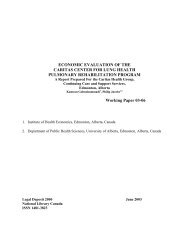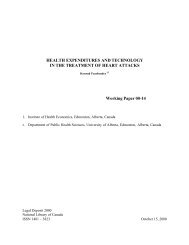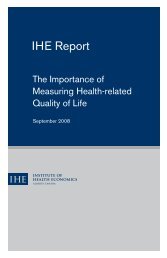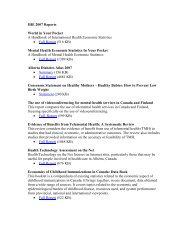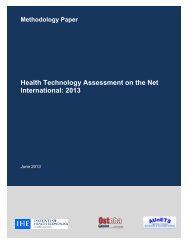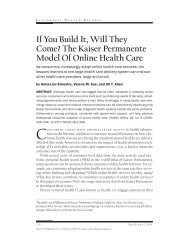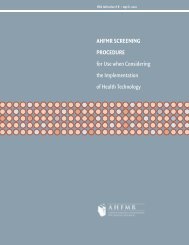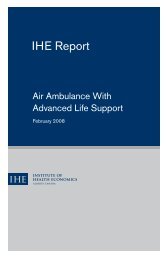Bariatric treatments for adult obesity - Institute of Health Economics
Bariatric treatments for adult obesity - Institute of Health Economics
Bariatric treatments for adult obesity - Institute of Health Economics
- No tags were found...
Create successful ePaper yourself
Turn your PDF publications into a flip-book with our unique Google optimized e-Paper software.
EXECUTIVE SUMMARYSocial and System DemographicsAdult <strong>obesity</strong> has emerged as a chronic medical condition characterized by an accumulation <strong>of</strong>excess body fat caused by a long-term energy imbalance that mainly results from complexinteractions <strong>of</strong> biological, environmental, and behavioural factors. In practice, it is defined accordingto body mass index (BMI), categorized as follows:BMI Range Type <strong>of</strong> Obesity Obesity Class30 kg/m 2 to 34.9 kg/m 2 mild <strong>obesity</strong> Class I <strong>obesity</strong>35 kg/m 2 to 39.9 kg/m 2 moderate <strong>obesity</strong> Class II <strong>obesity</strong>40 kg/m 2 or greater severe/extreme/morbid <strong>obesity</strong> Class III <strong>obesity</strong>Adult <strong>obesity</strong> is associated with multiple organ-specific and psychosocial consequences that mayresult in reduced quality <strong>of</strong> life and increased morbidity and premature mortality. The most seriousadverse health risks and consequences are associated with severe (class III) <strong>obesity</strong>.In Canada, as in other countries, the prevalence <strong>of</strong> <strong>obesity</strong> during the past 30 years has increasedprogressively within all demographic groups and continues to rise. This increase is influenced bynumerous individual-level and environmental factors.Among Alberta’s 2007 population <strong>of</strong> <strong>adult</strong>s (aged 18 years and over), 17.7% were classified as obese,with 12.5% in class I, 3.7% in class II, and 1.5% in class III. These rates were based on self-reporteddata from the 2007 Canadian Community <strong>Health</strong> Survey (CCHS). They are considerably lower thanthe latest available directly measured rates from the 2004 CCHS data, where the measured <strong>adult</strong><strong>obesity</strong> rate was 25.2% and the rates <strong>for</strong> classes I, II, and III <strong>obesity</strong> were 15.4%, 6.7%, and 3.2%,respectively.According to evidence-based recommendations, when addressing <strong>adult</strong> <strong>obesity</strong>, both preventionstrategies (to keep more individuals from becoming obese) and bariatric therapy (to assist thosediagnosed with <strong>obesity</strong> in managing their weight problems) should be considered. A comprehensiveand multisectoral approach to <strong>adult</strong> <strong>obesity</strong> prevention is recommended. Lifestyle and behaviouralmodification, based on intensive patient education and counseling, is recommended as an essentialpart <strong>of</strong> effective <strong>adult</strong> <strong>obesity</strong> management. Pharmacotherapy may be added if lifestyle andbehavioural modification interventions alone are insufficient. For severe and moderate <strong>obesity</strong> (BMI≥ 40 kg/m 2 and BMI ≥ 35 kg/m 2 with comorbidities) refractory to appropriate non-surgical<strong>treatments</strong>, bariatric surgery may be an appropriate option when combined with long-term lifestylemodifications.<strong>Bariatric</strong> treatment options should be stratified according to BMI and waist circumferencemeasurements, the presence <strong>of</strong> associated health risks and consequences, readiness <strong>for</strong> change andwillingness to comply with an individualized treatment plan, and failure <strong>of</strong> previous bariatric<strong>treatments</strong>. Key components <strong>of</strong> quality bariatric care include:appropriate selection <strong>of</strong> patients <strong>for</strong> each treatment strategy;the availability <strong>of</strong> a multidisciplinary team that includes dedicated and appropriately trainedand credentialed personnel;<strong>Bariatric</strong> <strong>treatments</strong> <strong>for</strong> <strong>adult</strong> <strong>obesity</strong> – March 2012ii



